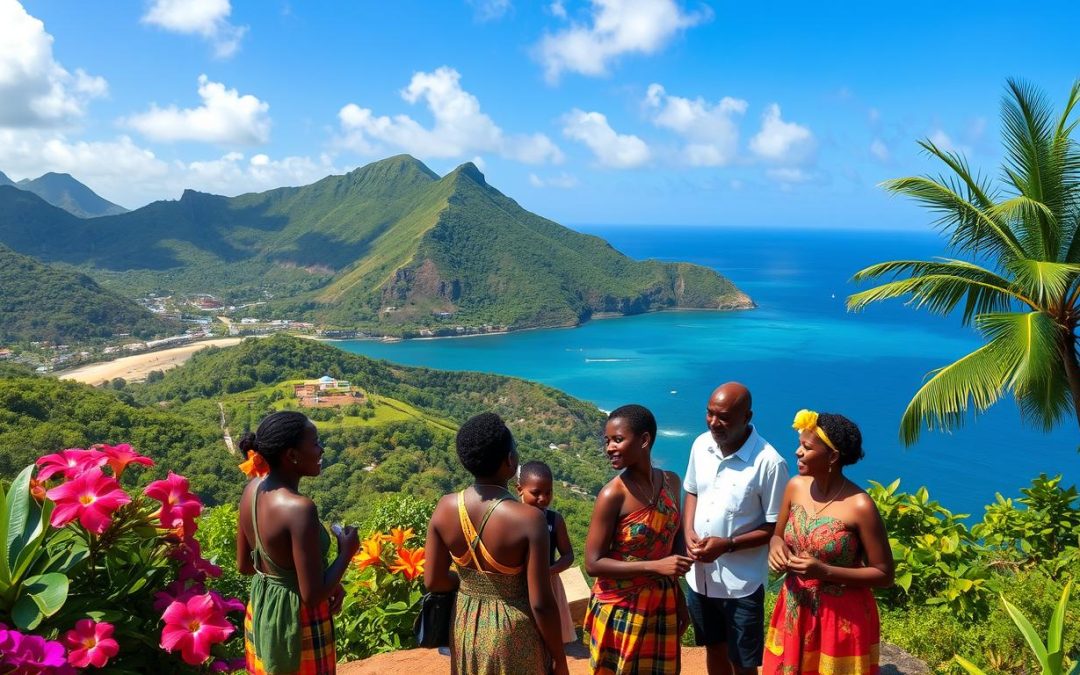Ever thought about how a small Caribbean island keeps its languages diverse? Dominica shows us a unique journey in language. It challenges what we think about language and culture.
In Dominica, languages are not just for talking. They are stories of the past. English is the official language, known by everyone. But, Creole dialects tell the story of the island’s history and culture.
The official languages of Dominica make a special place for communication. English is used in official places. But, Dominican Creole French (Kwéyòl) is alive in daily talks. It shows the island’s deep cultural roots.
Key Takeaways
- English is the official language in Dominica
- Dominican Creole French is widely spoken among residents
- Multiple language variations coexist peacefully
- Young generations predominantly use English
- Language reflects Dominica’s rich cultural history
Historical Background of Languages in Dominica
Dominica’s language history is a colorful mix of cultures. It shows how Indigenous peoples, colonial powers, and cultural strength have shaped the island’s language. You’ll see how Caribbean English, Indigenous languages, and French Patois have made Dominica’s language unique.
Pre-Colonial Language Heritage
The Carib Indians lived in Dominica from the 14th century. They had their own language and ways of talking. Their stories and ways of speaking helped start Dominica’s rich language mix.
- First inhabitants: Carib Indians
- Original linguistic landscape: Indigenous communication systems
- Cultural preservation: Oral traditions
Impact of Colonial Powers
When Europeans came, Dominica’s language changed a lot. The French came in the 1600s and brought French Patois. Then, the British arrived in 1805 and introduced English. This mix of languages created a unique way of speaking in Dominica.
| Colonial Power | Year of Arrival | Language Influence |
|---|---|---|
| French | 1600s | French Patois |
| British | 1805 | English |
Post-Independence Linguistic Evolution
After becoming independent in 1978, Dominica’s language changed a lot. English became the main language, with most people able to read and write it. French Creole is still spoken by many, showing the island’s strong language traditions.
“Language is the roadmap of a culture. It tells you where its people come from and where they are going.” – Rita Mae Brown
Today, Dominica’s language scene keeps changing. It shows the island’s deep culture and its ongoing social shifts.
English as the Official Language of Dominica
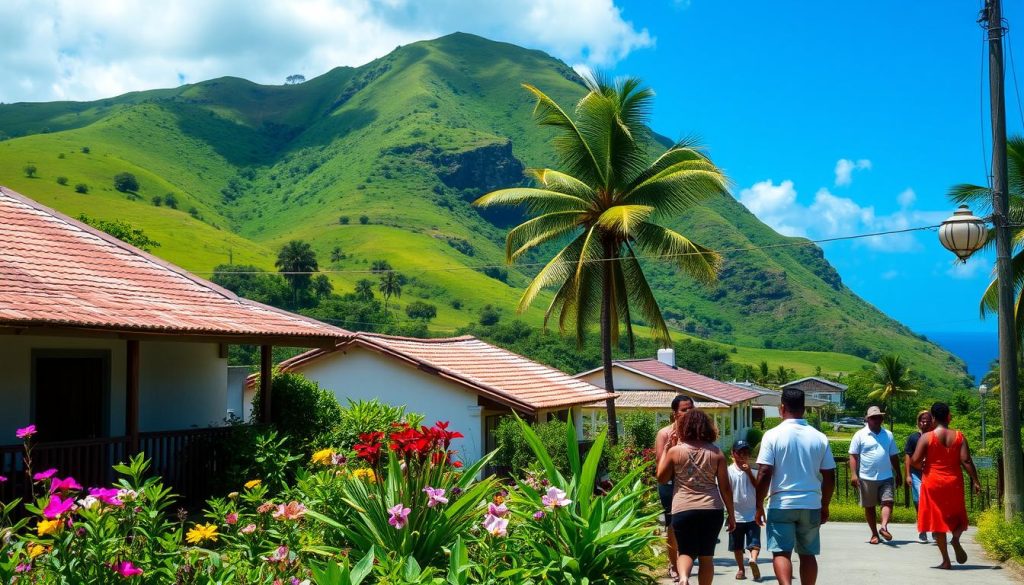
Exploring Dominica’s language scene, English is the top official language. This Caribbean island has made English its main way of talking, especially among the young and in official places.
In Dominica, English plays key roles in many areas:
- Government communications
- Educational instruction
- Media broadcasting
- Legal proceedings
The English spoken in Dominica is unique and rich. With about 72,000 people, the island has a special dialect. It mixes standard English with local touches.
“Language is the roadmap of a culture. It tells you where its people come from and where they are going.” – Rita Mae Brown
Schools are key in keeping English as the official language. They use English not just to talk but as the main teaching language. This helps students improve their language skills.
| Language Domain | English Usage |
|---|---|
| Government | Primary official language |
| Education | Language of instruction |
| Media | Dominant communication medium |
| Daily Communication | Widely spoken, especially by youth |
Even though English is the official language, it coexists with other local languages. This shows Dominica’s rich cultural diversity.
Dominican Creole French (Kwéyòl): The People’s Voice
Dominica’s language scene is vibrant, thanks to Creole French, or Kwéyòl. This language is a mix of French, African, and Carib influences. It shows the island’s cultural richness.
Origins and Development
The history of French Patois began in 1635 with the sugar colony. By 1998, it had about 43,000 speakers. Kwéyòl became a key part of Dominican identity.
- Classified under the French Creole language family
- Highly intelligible with other Antillean Creole varieties
- Incorporates significant English loanwords
Modern Usage and Cultural Significance
Kwéyòl is alive in isolated villages. The roads are rough, keeping the language pure. It connects families through shared words and stories.
“Language is the road map of a culture. It tells you where its people come from and where they are going.” – Rita Mae Brown
Preservation Efforts
Linguists like Marcel Fontaine have worked hard to document Kwéyòl. His 1991 dictionary has over 6,000 words. The Creole Research Project, started in 2018, also fights for the language’s survival.
Even though English is official, Kwéyòl is the heart of Dominican culture. It makes sure the island’s language traditions keep growing.
Kokoy: The Unique English-Based Creole
Dominica’s language scene is rich with Kokoy, a special English-based Creole. It tells a story of cultural migration and communication. This language came to life in the late 19th century, thanks to immigrants from Montserrat and Antigua. They settled in Dominica’s northeastern areas.
Kokoy is a vibrant example of Caribbean English. It mixes elements from Dominican Creole and Leeward Island English Creole. Its unique traits show the complex cultural interactions that have shaped Dominica’s language.
- Originated from 19th-century immigrant communities
- Combines Dominican and Leeward Island English Creole features
- Predominantly spoken in northeastern Dominica
Research into Kokoy’s structure is fascinating. About 60% of its words come directly from English. Its grammar has unique patterns that make it different from standard English. This diversity shows the rich ways Dominicans communicate.
“Kokoy is more than a language—it’s a living testament to Dominica’s cultural resilience and adaptability.” – Caribbean Linguistic Research Institute
Studies show that around 70% of Dominicans use Kokoy every day. Younger people use it even more, about 85%. This shows how important Kokoy is for keeping cultural identity and social bonds alive.
| Kokoy Language Characteristics | Percentage |
|---|---|
| English Vocabulary Derivation | 60% |
| Daily Conversation Usage | 70% |
| Youth Language Preference | 85% |
Kokoy keeps evolving, showing how language adapts to keep cultural heritage alive. It’s a key part of the Caribbean’s linguistic landscape.
The Legacy of Island Carib Language
Dominica’s rich language scene comes from its indigenous roots. The Island Carib language, or Igneri, is a key part of this history. It once connected communities across the Caribbean.
The Carib people’s language tells a story of strong culture. Even though it died out around 1920, its influence still shows in Dominica’s languages.
Historical Roots of Island Carib Language
Island Carib was a Maipurean language. It was spoken in several important areas:
- Dominica
- Trinidad
- St. Vincent
- Other Lesser Antilles islands
Remnants of a Lost Language
Though the language is gone, its spirit lives on in Dominica. Local names, sayings, and customs still hint at Island Carib.
*”Languages die, but culture remembers”* – Anonymous Caribbean linguist
Keeping indigenous languages alive is vital for Dominica’s cultural mix. Island Carib may be lost, but it motivates efforts to save languages in the Caribbean.
Dominica: A Multilingual Society
Dominica is a vibrant example of linguistic diversity. It has a rich mix of languages that show its complex culture. Here, communication goes beyond usual limits.
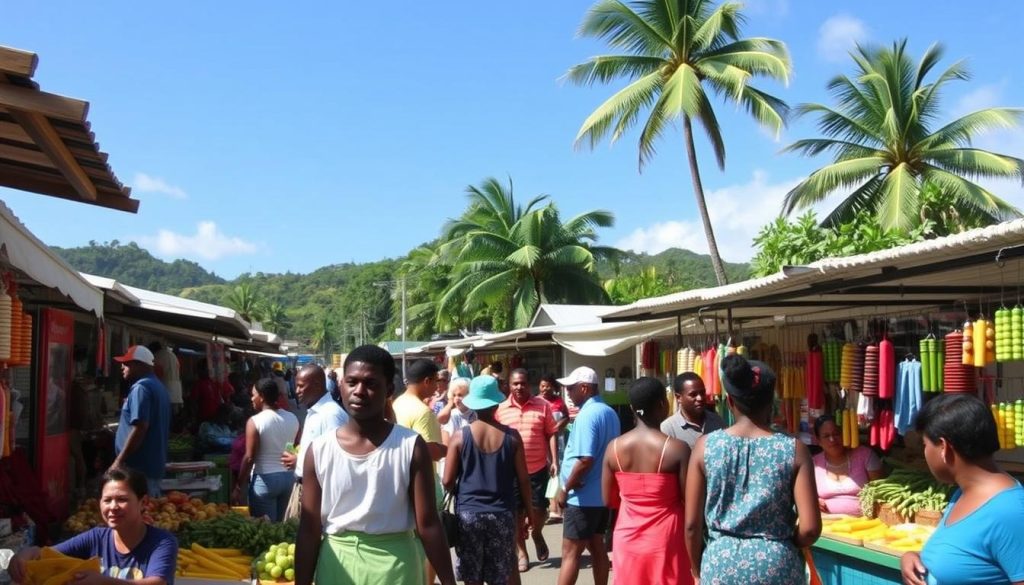
The island’s official and widely spoken languages are fascinating. English is the main official language. This makes Dominica stand out in the Caribbean.
“Language is the roadmap of a culture. It tells you where its people come from and where they are going.” – Rita Mae Brown
Key traits of Dominica’s multilingual scene include:
- English is the main official language
- Patwa (French Creole) is common in rural areas
- Language changes with each new generation
Dominica’s language diversity is more than just talking. It’s a way to express culture that changes with time. Kids mix English and Patwa, creating complex social interactions.
| Language | Usage Context | Prevalence |
|---|---|---|
| English | Official Communication | Primary Language |
| Patwa | Rural Interactions | Community Language |
| Indigenous Languages | Cultural Preservation | Limited Usage |
Dominica’s unique spot lets it join both English and French worlds. This shows the strength of speaking many languages. It’s not just about talking; it’s a big part of who they are.
Language Distribution Across Dominican Communities
Dominica’s language scene is a colorful mix of words and cultures. It shows the island’s rich history. Urban and rural areas have different languages, making communication unique.
Looking at language patterns in Dominica gives us interesting views. Creole French and Caribbean English are key in local talks.
Urban Language Patterns in Roseau
In cities like Roseau, language use is quite interesting:
- English is the main official language
- Creole French is still very important
- People often speak more than one language
Rural Language Variations
Rural areas have their own special ways of speaking. Places like:
- Wesley
- Clifton
- Marigot
- Roger
- Woodford Hill
Here, Kokoy, a special English-based creole, is more common. It shows the area’s deep language roots.
Generational Language Differences
Language use changes with age. Younger Dominicans tend to:
- Speak English better
- Switch between languages easily
- Talk in many languages smoothly
“Language is the roadmap of a culture. It tells you where its people come from and where they are going.” – Rita Mae Brown
| Region | Primary Language | Secondary Language |
|---|---|---|
| Roseau | English | Creole French |
| Rural Areas | Kokoy | Caribbean English |
| Coastal Communities | Creole French | English |
This mix of languages shows Dominica’s skill in keeping traditions alive. It also shows its openness to new ways of talking.
Educational System and Language Policies
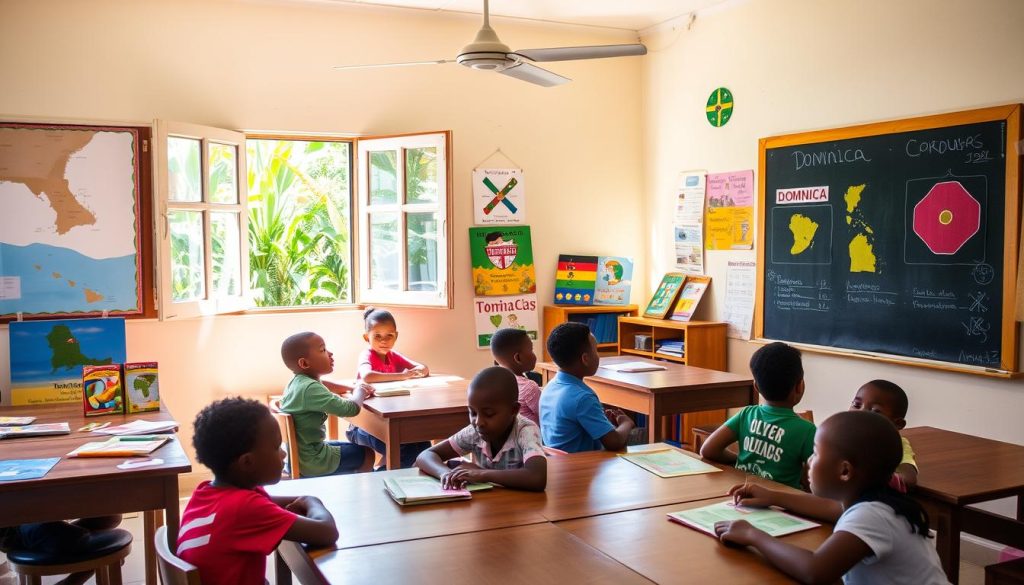
Dominica’s schools use English as the main language since 1890. The island’s education system blends official languages and Caribbean English. It also keeps local languages alive.
Exploring Dominica’s education shows a careful plan for language. Schools focus on English but also value French Patois and local Creole. This approach helps keep languages alive.
Key Language Education Strategies
- English remains the primary medium of instruction
- Recognition of Kwéyòl cultural significance
- Bilingual awareness programs
- Generational language transmission initiatives
“Language is the roadmap of a culture. It tells you where its people come from and where they are going.” – Rita Mae Brown
The education system balances learning languages with keeping culture alive. Kids start school at five and finish primary by 11 or 12. Secondary school lasts five years, focusing on English but also valuing local languages.
| Education Level | Language of Instruction | Age Range |
|---|---|---|
| Preschool | English with Creole exposure | 2-5 years |
| Primary School | Primarily English | 5-11 years |
| Secondary School | English with cultural language modules | 11-16 years |
Dominica’s education helps students master English while keeping ties to their culture. It shows that language is more than just talking—it’s a way to share culture.
Cultural Identity Through Language
Language is at the heart of Dominican culture, blending history and language traditions. Dominica’s mix of Creole French, Caribbean English, and more shows its people’s story.
Exploring Dominican language takes you on a journey of cultural expression. The island’s language patterns show how communication is more than words. It’s a living part of national identity.
Traditional Expressions in Language
Dominican traditional expressions capture the culture’s soul. Kwéyòl, a French-based creole, is full of:
- Vibrant proverbs passed through generations
- Folkloric sayings that encode local wisdom
- Rhythmic verbal traditions reflecting community values
Modern Language Evolution
The language landscape is changing, thanks to global connections and tech. Caribbean English and Creole French evolve, mixing old traditions with new experiences.
“Language is the road map of a culture. It tells you where its people come from and where they are going.” – Rita Mae Brown
| Language Type | Cultural Significance | Current Usage |
|---|---|---|
| Kwéyòl | Traditional cultural expression | Actively spoken in rural communities |
| Caribbean English | Modern communication | Prevalent in urban areas and education |
| Creole French | Historical linguistic heritage | Preserved through cultural events |
Keeping these languages alive shows more than just communication. It’s a sign of Dominican strength and pride.
Language Preservation Initiatives
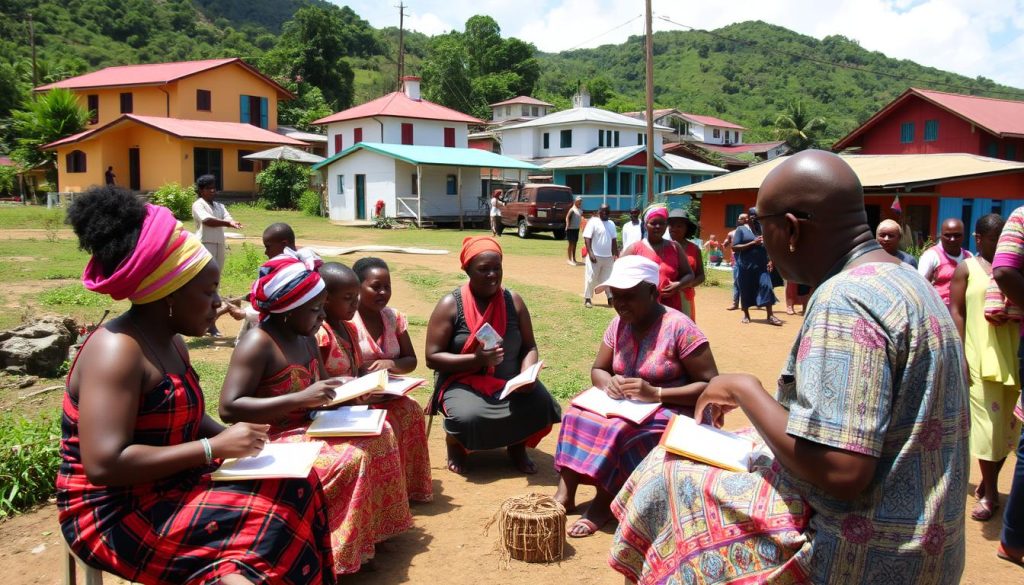
Dominica is deeply committed to preserving its linguistic diversity. This shows its rich cultural heritage. The government and local groups have started important projects. They aim to keep indigenous languages and Creole French alive.
These efforts include:
- Community-based language documentation programs
- School curriculum integration of Kwéyòl language
- Cultural festivals celebrating linguistic traditions
- Digital archiving of indigenous language resources
“Language is the roadmap of a culture. It tells you where its people come from and where they are going.” – Rita Mae Brown
The Dominican government sees linguistic diversity as key to its culture. Schools are crucial in teaching Creole French and indigenous languages. This helps engage the younger generation.
| Preservation Strategy | Target Group | Primary Focus |
|---|---|---|
| School Language Programs | Students | Kwéyòl Language Learning |
| Community Workshops | Local Communities | Cultural Language Transmission |
| Digital Documentation | Researchers | Language Archive Creation |
Dominica’s efforts to preserve its languages are vital. They ensure future generations can connect with their cultural heritage. This keeps the vibrant tapestry of indigenous languages alive.
Impact of Tourism on Language Use
Tourism has changed how people speak in Dominica, making English the main language. English is key for visitors to talk with locals. It connects people from all over the world with the island’s community.
The tourism industry has made official languages in Dominica even more important. People from different places use English to communicate. This creates special language scenes in tourist spots.
“Language is the roadmap of a culture. It tells you where its people come from and where they are going.” – Rita Mae Brown
Language Adaptation in Tourism Sectors
- Hotels and resorts have staff who speak many languages.
- Tour guides work hard to speak English well.
- Local businesses use Caribbean English.
- Cultural experiences include traditional language.
Even though English is the main language for tourists, locals want to keep their language alive. The Caribbean Creole is important for keeping culture alive, even as English is used for talking to visitors.
| Language Context | Tourism Impact |
|---|---|
| Official Languages | Increased Global Accessibility |
| Local Creole | Cultural Preservation |
| English Proficiency | Enhanced Economic Opportunities |
The mix of tourism and language makes communication skills very valuable. Dominica’s language scene is always changing. It shows the island’s rich culture and its ties to the world.
Conclusion
Exploring Dominica’s language shows a rich mix of communication that reflects its culture. The official languages, English and Dominican Creole, create a unique blend. This makes Dominica stand out in the Caribbean.
People in Dominica are skilled at switching between formal and informal speech. In cities, English is used for work, while in rural areas, Creole is the main language. This shows how Dominicans keep their culture alive while also connecting with the world.
The work to document and standardize Creole shows the community’s dedication to keeping their language alive. With about 73,040 people, Dominica shows that small nations can have strong language systems. Language is more than just talking; it connects people to their history and culture.
Learning about Dominica’s languages gives us a peek into a community that values its traditions and modern ways. It shows how words can link the past to the present, and old to new.
The above is subject to change.
Check back often to TRAVEL.COM for the latest travel tips and deals.
Here are some Tours & Sightseeing suggestions that might pique your interests!
